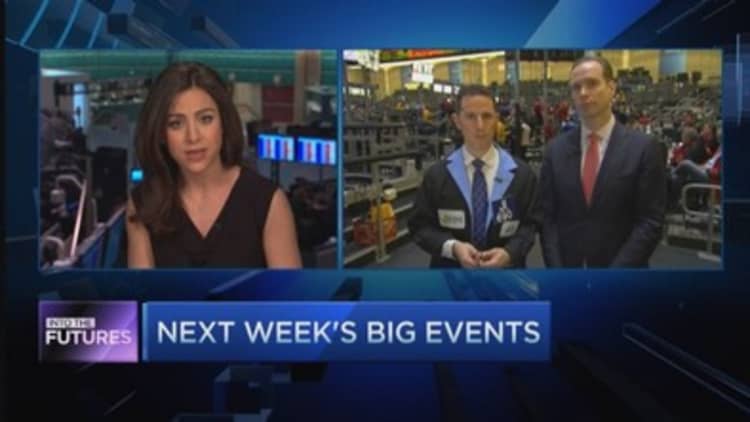
Stocks and bonds have always responded to the latest economic data releases. But with the Federal Reserve potentially set to hike rates as early as June, the markets' data dependency could degenerate into a full-out data addiction.
It's not that investors have suddenly taken a greater interest in the growth rate of the economy. Rather, since the general trend of growth puts the Fed on pace to hike raise, each individual data point is starting to take on a greater import.
Some even suggest that this is by design. That is, the Fed may be creating a deliberate show of tying policy to data, in order to slowly reacquaint the market with volatility after years of quiescent gains.
Read More It's all about the Fed, but watch for these flareups
With the Fed "deemphasizing forward guidance, we believe that the market finally is truly data dependent," Bank of America Merrill Lynch (BofAML) rates strategists wrote in a recent note. "The sensitivity to data surprises is much greater today compared with the last few years, and we expect it to continue into the first hike."
The strategists point out that the frequency of massive daily moves in interest rates (and bond prices, which move inversely to rates) have increased dramatically.
In fact, rate volatility is about as high as in the mid-2013 "taper tantrum," when the Fed weighed pulling back on quantitative easing. And many of the recent moves are in reaction to important economic data releases such as the jobs report—the BofAML team points out that rates on 2-year and 10-year Treasury instruments "have moved twice as much on payroll days since October compared to the 10 months prior."
Fed losing its 'patience'
With the Fed's next statement set to be released on Wednesday, the latest market parlor game is whether the Fed will drop the word "patient" from its guidance about the pace at which it will normalize monetary policy.
Many do expect the word to vanish, which would open up the Fed to hiking rates as early as June, according to the "two meetings" rubric Fed Chair Janet Yellen laid out before Congress. This could force the Fed to look more closely at each upcoming data point, as it makes certain whether the economy is finally ready for a hike.
Whatever the Fed looks at, investors and traders are certain to inspect it closely as well.
For instance, stocks rose sharply on Thursday's open after the retail sales number for February showed a surprising 0.6 drop. The bullish interpretation of the dire figure was that the Fed won't raise rates if the consumer continues to struggle.
Read More U.S. retail sales fall in February, weather likely a factor
Still, whether the Fed is truly as data-dependent as it claims remains an open question.
"The Fed might pretend like they're really responsive to little swings in data, but you're still at emergency levels of interest rates right here, so you'd need to see a significant shift to cause big changes in the Fed's plans," said Michael Cloherty, the head of US rates strategy with RBC Capital Markets. He expects that the Fed will drop the "patient" language on Wednesday, and initiate the first rate hike in June.
For the strategist, it ultimately comes down to liquidity. Due in part to regulatory pressures and constraints, bonds have become a lot less liquid of late. (As BofAML points out, "the average 1st level book depth in Treasury futures has been halved in 2015 compared to the previous two years.") And that could put the Fed in a bit of a box.
"If you're super responsive and swing dramatically off of every nuance in every data flow, you're generally going to do more damage than good," he said. "Given current levels of liquidity, the market simply can't respond to major shifts in sentiment."
Still not clear
Wall Street is unsure not only when the Fed will normalize policy, but why. As a result, it's become a tough time to commit money in the fixed income world.
"This fixed income market is one of the least convicted that I've ever seen in terms of trades that are being placed," said Karissa McDonough, director of fixed income strategy for People's United Bank Wealth Management.
"People are very uncertain—not so much over when the Fed will raises rates or what the pace of change will be, but if the Fed is truly data-dependent," she added. "It seems that the data is not yet supportive of a rate increase, but it simply isn't clear."
Yet "perhaps the Fed wants to enter a period of more normalized markets in terms of volatility—sort of shock the market now so that it's not shocked later," McDonough suggested.
In other words, the new version of "not fighting the Fed" may be to play for (or at least prepare for) greater volatility over the next few months, particularly in U.S. Treasurys.
—By CNBC's Alex Rosenberg.
Watch "Futures Now" Tuesdays & Thursdays 1 p.m. ET exclusively on FuturesNow.CNBC.com!



